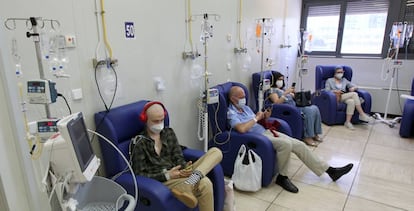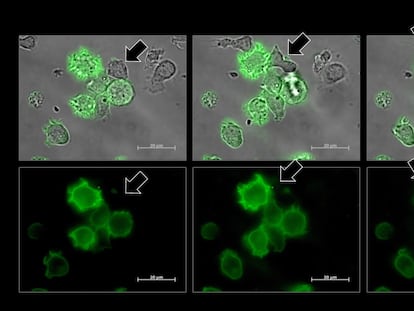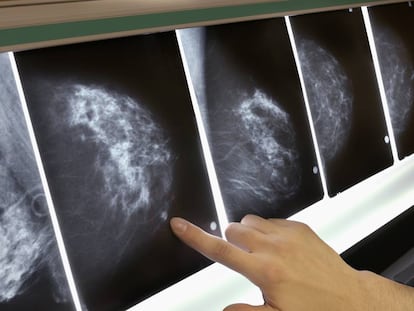Women suffer more after cancer treatments than men, study finds
New research reveals a 34% higher risk of adverse after-effects, especially following immunotherapy


A new study by US scientists published in the Journal of Clinical Oncology reveals that, after receiving cancer treatment, women have a 34% higher risk than men of developing serious adverse after-effects.
For cisplatin, a common chemotherapy drug used to treat advanced tumors, some 30 adverse effects are listed, with around 100 for pembrolizumab, an antibody used in immunotherapy.
The researchers reviewed the results of phase II and III clinical trials conducted by the SWOG cancer research center between 1980 and 2019, excluding results from trials on tumors specific to sex (such as breast or prostate cancer). In total, the results analyzed pertained to about 23,300 patients. A total of 38% were women, who between them registered nearly 275,000 adverse effects.
Joseph M. Unger is a biostatistician at the Fred Hutchinson Cancer Research Center and the leading author of the study. “We found especially large increases in severe toxicity [the extent to which something is poisonous or harmful] in women compared to men who received immunotherapies.”
“Given the increasing use of these new and important treatments, better understanding the magnitude and the causes that underlie these differences must be a priority,” the researcher explains over email to EL PAÍS.
Unger says that, while the scientific community already knew that the outcomes of cancer therapies differed between men and women, studies on the topic have hitherto been limited to evaluating the impacts of chemotherapy and its results regarding survival and disease progression.
“This is the first study to systematically assess, in a large sample, differences in treatment toxicity between men and women for traditional chemotherapeutic approaches as well as novel therapies such as targeted therapies and immunotherapies.”
Unger’s team has confirmed that women suffered more toxicity than men from the treatments and also had a higher risk of serious adverse effects on blood and tissue cells, especially in patients with colon cancer who received complementary treatment along with the main therapy.
The study does not specify the reason for these differences, but experts point to several hypotheses.
“There may be differences in the extent to which women and men report adverse events, and there may be differences in how well they adhere to medications. Women and men may also differ in how they physically process medications,” Unger notes. Women, for example, are less able to eliminate fluorouracil, a cancer treatment that kills cells growing out of control.
We all sensed that women experienced more side effects, but official science said no. This is going to make us change the way we test drugsRafael López, president of the Spanish Foundation for Excellence and Quality in Oncology
The study also shows that the intestinal microbiome (the bowel’s ecosystem of micro-organisms) may also have a role in explaining differences in how women and men metabolize drugs due to the role of that body part in regulating inflammation, immunity and metabolism.
Men and women may perceive and report ailments differently, Unger says, and this may partly account for the higher percentage of women having adverse effects from their cancer treatment. “But only partly,” says the expert. Overall, “we observed more severe toxicity in women, and these assessments are based entirely on objective laboratory measures.”
For Rafael López, president of the Spanish Foundation for Excellence and Quality in Oncology, the study has confirmed something that doctors treating cancer had already suspected:
“We all sensed that women experienced more side effects, but official science said no. This is going to make us change the way we test drugs, regulate them and administer them,” says López, who is also head of Oncology at the Santiago de Compostela Hospital.
Going forward, “studies must be designed taking gender into account,” he concludes.
Ruth Vera, coordinator of the Women in Oncology Commission of the Spanish Society of Medical Oncology, agrees that Unger’s research shows that “there is an influence of sex on the toxicity of treatments and it should be taken into account when administering drugs and when dosing them.”
Both oncologists, who were not researchers on the study, also endorse the hypotheses about the causes of women experiencing adverse effects in higher numbers than men.
Vera notes that “adherence to oral treatments is greater in women than in men” and the immune system in both sexes also behaves differently.
López agrees that “the hormonal system that makes men and women different has implications for the immune system” and it is necessary to adjust drug treatments according to sex: currently, “doses are adjusted to weight or body surface area, but in the future they will also be adjusted by sex or according to their hormonal situation [e.g. a patient of premenopausal or postmenopausal age will not be the same].”
Gender inequality in clinical trials
Narjust Duma, an oncologist at the Dana-Farber Cancer Institute and a professor at the Harvard School of Health, goes one step further and warns that there are gender inequalities in oncology that are there “from the beginning”: differences in adverse effects, for example, have been recorded in preclinical studies over a long period of time.
Duma, who also did not participate in Unger’s study, says “one of the big problems in cancer research is that we use male cells.”
“When you study a drug in the lab before testing it on humans, you use animal models, like mice, and they’re usually male mice.”
Indeed, “most of the preclinical data comes from the cell lines of male animals and the data we have is that the drug is potentially good… for men, but it hasn’t been tested in women.”
That inequality continues in clinical trials, says Duma.
“More men participate in trials. For example, in immunotherapy trials, only 30% of the people who participate are women.”
“So why are there these inequities [in adverse effects]? Because we don’t test these drugs in women until clinical trials and when these studies come, only a small percentage of women get the offer to participate in them,” notes the specialist.
Duma published an article in the journal Oncology which also confirmed a higher prevalence of adverse effects in women with melanoma or lung cancer after receiving a type of immunotherapy. The study revealed that they could have a higher risk of after-effects associated with the immune system and be more likely to develop endocrinopathies [hormone disorders, such as hypothyroidism] and pneumonitis [inflammation of the lung tissue, such as in pneumonia].
According to Duma, “there are gender inequalities throughout the cancer care process,” and also in diagnoses and treatment. For example, in the case of bladder, lung or kidney tumors: “women suffer more delays in diagnosis and treatment because these tumors are normally attributed to older men,” making doctors less likely to look for these cancers. To be sure, with social and media focus trained so much on breast cancer, other types of tumors are “forgotten”: “We live in a bubble where we believe that women are only affected by [breast cancer], and that’s not true.” In fact, “more women die from lung cancer.”
In an article in the journal Nature, Duma says: “The research community continues to see lung cancer as a disease of older men, and the consequences of this stereotyping can be detrimental to women, causing significant delays in diagnosis.”
Unger and his team encourage having more awareness and understanding about the differences between men and women, and why they are, in order to improve the quality of cancer therapies overall.
“Our hope and expectation is that cancer patients will increasingly receive individualized treatment, and that the sex of the patient can be an important element when considering individualized treatment options.”
Tu suscripción se está usando en otro dispositivo
¿Quieres añadir otro usuario a tu suscripción?
Si continúas leyendo en este dispositivo, no se podrá leer en el otro.
FlechaTu suscripción se está usando en otro dispositivo y solo puedes acceder a EL PAÍS desde un dispositivo a la vez.
Si quieres compartir tu cuenta, cambia tu suscripción a la modalidad Premium, así podrás añadir otro usuario. Cada uno accederá con su propia cuenta de email, lo que os permitirá personalizar vuestra experiencia en EL PAÍS.
¿Tienes una suscripción de empresa? Accede aquí para contratar más cuentas.
En el caso de no saber quién está usando tu cuenta, te recomendamos cambiar tu contraseña aquí.
Si decides continuar compartiendo tu cuenta, este mensaje se mostrará en tu dispositivo y en el de la otra persona que está usando tu cuenta de forma indefinida, afectando a tu experiencia de lectura. Puedes consultar aquí los términos y condiciones de la suscripción digital.
More information
Últimas noticias
Maduro pleads not guilty before the federal court in New York: ‘I am still the president of Venezuela’
A new test can detect Alzheimer’s from a finger prick
UN team enters Sudanese city of El Fasher after paramilitary massacre: ‘It’s like a ghost town’
A recipe for resistance: Indigenous peoples politicize their struggles from the kitchen
Most viewed
- Gilles Lipovetsky: ‘If you want to live better and fall in love, take Prozac, don’t look to philosophy’
- Alain Aspect, Nobel laureate in physics: ‘Einstein was so smart that he would have had to recognize quantum entanglement’
- Alvin Hellerstein, a 92-year-old judge appointed by Bill Clinton, to preside over Maduro’s trial in New York
- Why oil has been at the center of Venezuela-US conflicts for decades
- Maduro’s downfall puts China’s relationship with Venezuela to the test










































